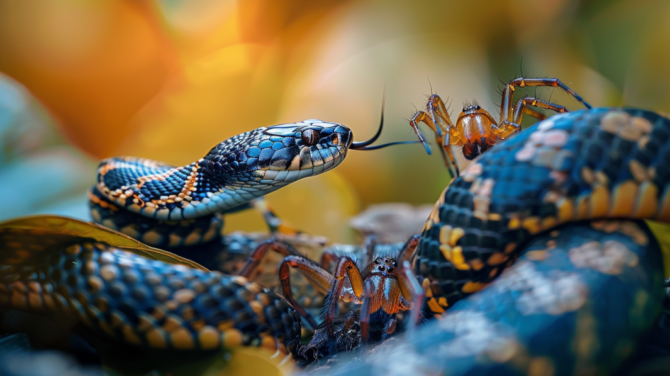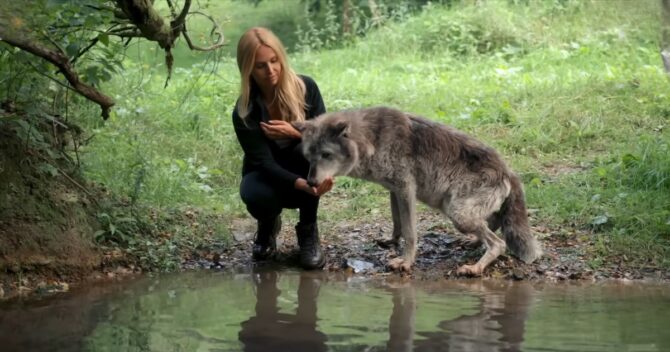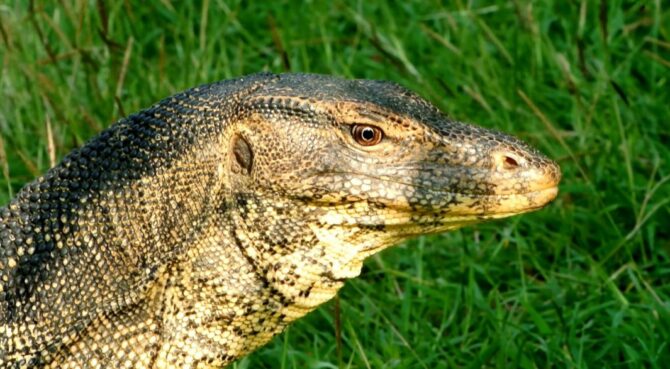Russia is a large country with a rich cultural history rooted in ballet, painting, and classical music.
The varied geography of Russia provides various habitats for its diversified wildlife population.
Most of these creatures are benign; however, some rank among the deadliest animals in the world and would not hesitate to snap life out of you if you don’t take precautions.
The most dangerous animals in Russia include brown bears, polar bears, gray wolves, and particular poisonous insects and venomous reptiles, to mention a few.
Read on to discover the deadliest creatures in Russia, why they are so dangerous, and some safety advice for dealing with wildlife.
What are the Most Dangerous Animals in Russia?
1. Gray Wolf (also Timber Wolf)
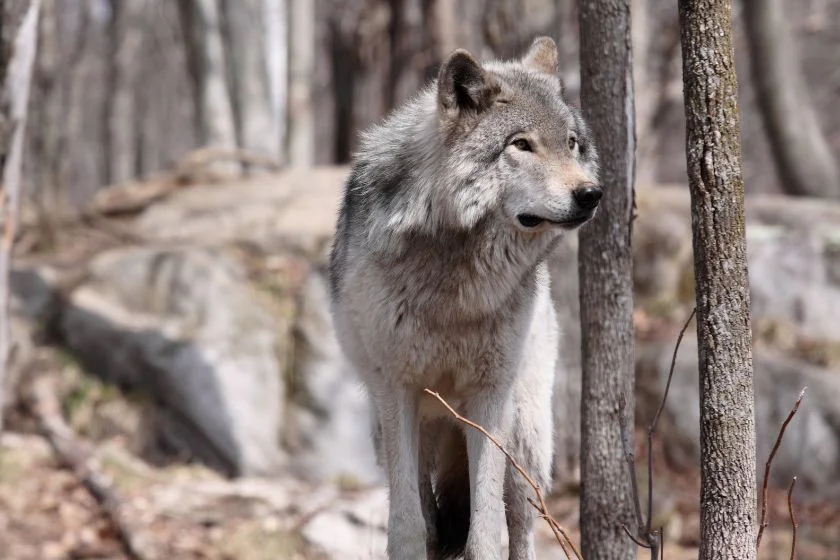
- Scientific name: Canis lupus
- Class: Mammal
- Habitat: Forests, wetlands, pastures, mountains, deserts
- Diet: Carnivore
- Conservation status: Least concern (population stable)
The largest populations of gray wolves are in Russia and Canada. In 2002, there was an estimated 45,000 population of wolves in Russia.
The largest member of the wild dog family is the grey wolf, commonly called the timber wolf.
Grey wolves are large animals with extremely thick coats, usually grey with black markings and lighter underparts.
However, they can also infrequently be black, brown, red, or even white. Males are bigger than females are. Male wolves have narrow chests, straight tails, long broad legs, and wide feet.
Wolves can successfully locate prey thanks to their great hearing and sense of smell. They can also take long steps because their long legs speed up the pursuit.
Although wolves normally avoid humans and steer clear of populated areas like buildings and roads, some wolves, especially gray wolves, are infamously dangerous and highly violent.
It’s essential to maintain a respectful distance from these wild dogs.
These typical hungry predators are at the top of our list because they are known to attack people in Russia.
2. Brown Bear

- Scientific name: Ursus arctos
- Class: Mammal
- Habitat: Desert fringes, high mountain forests, ice fields, tundra, alpine meadows
- Diet: Omnivore
- Conservation status: Least concern (population stable)
The Kamchatka brown bear or Far Eastern brown bear is one of Russia’s biggest and most well-known bears and has a large population. It is also the country’s official national animal.
The Anadyrsky district, Kamchatka peninsula, Karaginskiy island, Kuril islands, coastal strip west of the sea of Okhotsk southward to the Stanovoy Range, and Shantar islands in the Far East are home to the native brown bears of Russia.
The brown bears look like lumbering giants that may attack people without provocation, measuring between 2.4 and 3 meters (7.9 to 9.8 feet) in length and weighing 650 kilograms (1430 pounds).
But brown bears are very agile animals that are mostly harmless to people, despite how they appear and behave.
These Russian brown bears, like all bears, are omnivores and don’t regularly prey on people.
Only 1% of brown bear contact with people culminates in an attack; instead, curiosity or moms protecting their cubs are the main causes.
Brown bears are nimble animals despite how they behave and seem. Russian brown bear populations are thought to number around 100,000.
3. Polar Bear

- Scientific name: Ursus maritimus
- Class: Mammal
- Habitat: Continental coastlines, arctic sea ice, water, islands
- Diet: Carnivore
- Conservation status: Vulnerable and Endangered (population decreasing)
Because they have access to the majority of their prey, particularly seals, in these places, these white sea bears live on the drifting and coastal sea ice around the Arctic boundary, as their name suggests.
Polar bears have started migrating further south in recent years. However, climate change is harming their natural habitat.
The world’s greatest concentration of polar bear dens is on Wrangel Island. This is due, in part, to the region’s extensive underdevelopment.
Wrangel Island, which lies in Russia’s Arctic Far East, is frequently referred to as the maternity wing for polar bears.
It is critical to understand how dangerous polar bears may be because they are currently wandering into Russian cities in search of food.
Although they are typically portrayed in movies as being pleasant and harmless, polar bears are quite strong and dangerous animals.
It can cause significant harm like brown bears with a single sweep of its huge paws.
Treat them carefully and keep your distance because they only ever attack people when they feel threatened or when their habitat is damaged.
4. Wild Boar

- Scientific name: Sus scrofa
- Class: Mammal
- Habitat: Marshy swamplands, shrublands, wooded forests, grassy savanna areas
- Diet: Omnivore
- Conservation status: Least concern
In the mountainous regions of the Russian Far East, wild boars, also known as common wild pigs, are common.
They live in nut pine groves, hilly mixed forests with Mongolian oak and Korean pine, swampy mixed taiga, and coastal oak forests. Boars are only allowed in river valleys with nut pine and bushes in Transbaikalia.
The wild boar is a suid with short, rather slender legs that is hefty and enormously developed. Wild boars appear “uphill” because their hind legs are shorter than their front legs.
They physically differ greatly from domestic pigs in that they have smaller ears and considerably longer snouts. They also have straight tails with tufts at the tip. Brown to black hair coloring is common.
When wild boars are anxious or stimulated, long bristles that run from the head along the center line of the back can be elevated two to three inches from the body.
The Russian wild boar may reach lengths of up to six feet and weigh over 600 pounds. The capacity of a single wild boar to become larger depends heavily on genetics and nutrition.
According to experienced hunters, wild boars are considerably more aggressive than bears.
They can run at 40 km/h, making them extremely quick and nearly tough to kill with a single shot.
Wild boars can be dangerous and aggressive, especially females when protecting their offspring.
A boar’s heavy body can easily crush a person to death, but its sharp tusk is its most potent weapon.
Additionally, wild boars can transmit diseases, including hepatitis E, influenza A, and tuberculosis, to people and domestic animals.
Under no circumstances should you get close to these animals.
5. Amur Tiger (also Siberian Tiger)

- Scientific name: Panthera tigris
- Class: Mammal
- Habitat: Boreal and temperate mixed forests, mountain forests
- Diet: Carnivore
- Conservation status: Endangered (population stable)
Russian mountain forests in the east are a favorite place to see Amur tigers, previously known as Siberian tigers. They have light, slightly thick coats that allow them to endure Russia’s harsh winters.
It is important to stay on guard in the wild to avoid being surprised by an Amur tiger.
One of the biggest feral cats in the world, these tigers exhibit a cunning, dangerous, and cautious temperament. “Like John Cena, you can’t see these tigers coming.”
This is due to the fact that Amur tigers hunt covertly; they wait and approach their prey until they are close enough to spring and pounce fatally on them.
The ferocious predators mainly hunt and attack smaller animals like sika deers, red deers, and wild boars, but they will also attack humans if they are assaulted.
In Russia, there have been instances of unprovoked tiger attacks, but this only occurs once every four years (provoked attacks are much more common.)
6. Wels Catfish

- Scientific name: Silurus glanis
- Class: Fish
- Habitat: Flowing streams, lakes, ponds, sluggish streams, large reservoirs
- Diet: Omnivore
- Conservation status: Least concern
The Wels catfish, also known as the sheatfish, is a catfish native to a sizable portion of central, southern, and eastern Europe, specifically the basins of the Baltic, Black, and Caspian Seas.
This enormous fish can grow to be 5 meters (16 feet) long and weigh 360 kilos (793 lbs).
Even though they are uncommon, several Russian rivers still have these enormous catfishes.
These giant catfish have developed the ability to hunt other creatures whenever the occasion arises.
Most people will be surprised to learn that one of Russia’s most dangerous animals is the catfish, which has also been known to attack people in the area.
7. Tick

- Scientific name: Ixodida
- Class: Arachnid
- Habitat: Wooded areas, tall grass or bush
- Diet: Carnivore, hematophagous, parasitic
- Conservation status: Not extinct
These little critters are common throughout the vast Krasnoyarsk region, which stretches from the Mongolian steppes to the Arctic coast, as well as in Siberia, the Russian Far East, and certain areas of Western Russia.
In the region, according to government records, 1,925 persons reported bites during the week of May 22–28, and more than 10,000 bites were documented in 2020.
Some of the several diseases that can be contracted by tick bites include:
- Encephalitis: This is an acute inflammation of the brain’s active tissues that can cause memory loss, hearing loss, difficulty speaking, convulsions, and hallucinations in its victims.
- Lyme: A tick-borne bacterial infection that results in rash, fever, headaches, and exhaustion. It needs immediate medical attention.
8. Common Northern Viper
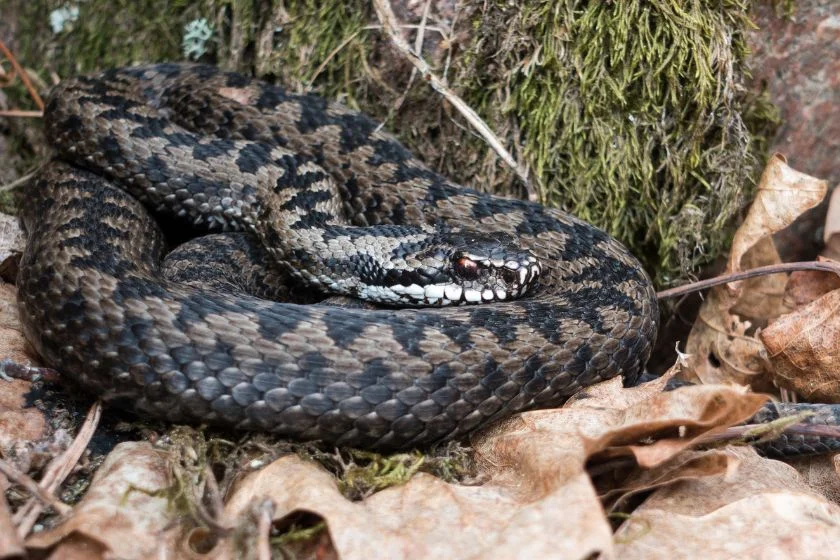
- Scientific name: Vipera berus
- Class: Reptile
- Habitat: Chalky downs, rocky hillsides, moors, sunny glides, clearings, coastal dunes, stone quarries
- Diet: Carnivore
- Conservation status: Endangered
Only 11 of the approximately 50 snake species in Russia have venom that can seriously endanger people.
One of the poisonous species in the nation is the Common European Adder, also called the Common Northern Viper. This snake can hide due to its camouflage characteristic and is present in the majority of the forests in Russia.
The common northern viper has a rattling tail, a colorful body, elliptical eyes, and a triangular head, similar to other venomous snakes.
These vipers can bite humans fatally if startled, despite their preference to avoid contact with people. This viper’s venom is toxic and strong enough to kill an older person or a youngster.
Adults who are bitten will feel pain and should get medical help. A generic antihistamine can be used to treat the majority of instances.
However, some individuals might experience anaphylactic reactions and be in a more serious condition.
9. Mediterranean Black Widow (also European Black Widow)
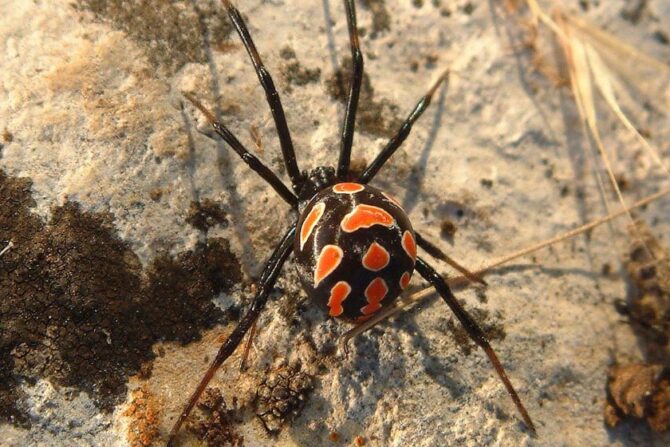
- Scientific name: Latrodectus tredecimguttatus
- Class: Arachnid
- Habitat: Agricultural lands, holes, and crevices
- Diet: Carnivore
- Conservation status: Least concern
The steppes of southern Russia are home to a widow spider known as the Mediterranean black widow, also called the European black widow.
These iconic spiders also reside in urban environments along with forests, deserts, and grasslands.
This species is distinguished by the thirteen spots on its dorsal abdomen, which are black in hue. These spots are typically red but can also be yellow or orange.
The black widow is one of the most dangerous spiders in Russia and the rest of the world. Since the male black widow can’t pierce the comparatively thick epidermis, the female’s bite is more harmful (to humans or cattle).
Although unpleasant, their bite seldom proves fatal. The widow’s bite can result in severe discomfort that will spread throughout the body if it is not carefully and quickly treated.
The venom works by disrupting cell membranes and causing nerve terminals to degranulate, which releases neurotransmitters.
If you have been bitten, please seek immediate medical attention.
If you don’t have access to one, professionals recommend burning the wound with a lit match to burn off any venom that hasn’t yet entered the body and lessen pain.
10. Lynx
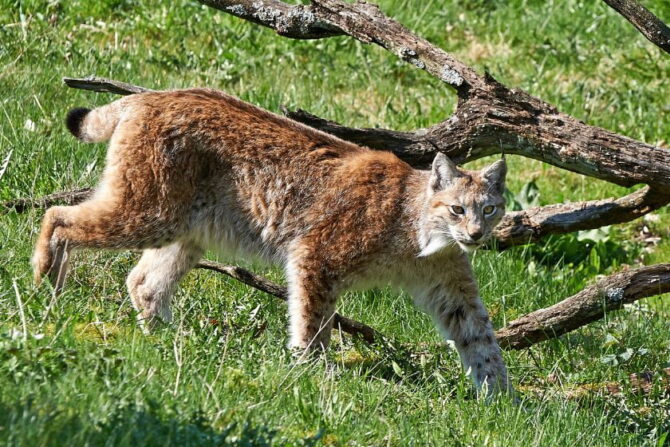
- Scientific name: Lynxes
- Class: Mammal
- Habitat: Boreal and deciduous forests, shrubs, mountains
- Diet: Carnivore
- Conservation status: Least concern (population stable)
Numerous wild cats, including the Eurasian lynx, can be found in Russia.
Russian lynx numbers were estimated to be around 22,510 in 2013; places like Kamchatka and Sakhalin are regarded as abundant and stable.
The Eurasian lynx can be recognized by its short tail, long white facial ruff, and a tuft of black fur on the tops of its ears. It has long, silky fur that serves as insulation and aids in surviving the winter’s cold.
The lynx, which is almost the size of a large dog, has an intimidating appearance.
A lynx is more comfortable perched atop a tree, where it keeps an eye out for unwary prey and can launch an assault when necessary.
Humans are not on the lynxes’ menu, yet they occasionally attack. When threatened, they are capable of being hostile and fierce.
Lynxes typically avoid humans, although they occasionally prey on people since they are opportunistic predators.
Because they move stealthily, sneak up on their victim, then strike them as hard as possible, lynxes are known as “shadow killers.”
No human has been reported to have died due to a lynx attack, but we have heard of reports of humans being hurt only because the lynx felt cornered and was attempting to defend itself.
Russia Wildlife Safety Tips
Nature time has numerous positive effects on both physical and mental well-being.
But it’s crucial to keep in mind that many different species call our wild areas home, not simply for our entertainment.
To avoid a bad experience with a wild animal, go by these professional safety tips:
1. Don’t hike alone
Always go on trips in pairs or small groups. Inform a third party of your whereabouts and anticipated return time before you leave.
Small children and loners are the first things predatory animals will target, so stick together and keep any kids in your group nearby.
2. Before you travel, do some local wildlife research
Knowing which animal to react to based on their behavior requires accurate animal identification.
3. Do not hike at dawn or dusk
Bears and other predators are most active during dawn and dusk. Because big cats like the Amur Tigers are nocturnal, avoid hiking at night in mountainous areas.
Bring a powerful animal repellent like a mace with you if you venture out after dark.
4. Remain distant
There’s a good chance you’ll run into a wild animal if you spend any time in the woods.
Respecting the animals’ personal space is one of the best methods to keep yourself safe in the wild.
Always maintain a distance of at least 50 yards from them. Don’t assume an animal is harmless just because it consumes plants.
It’s important to practice proper safety measures when exploring the environment to prevent unpleasant encounters with the local wildlife.
Treat every living thing with the utmost respect and dignity, keeping in mind that you are now in their home.
5. Never feed wild animals
Sharing your goodies with the local wildlife can be alluring, but you’re probably doing more harm than good.
Feeding these wild animals will make them come to think of humans as possible food sources, which might result in vicious bites and scratches.
6. Do not run
Running away is never a good idea, especially if bears stand right before you. They’ll have no choice but to respond to your pursuit by attacking you.
Do not run, especially if the animal is not chasing you; back away slowly till you find cover.
Conclusion
The listed most dangerous animals in Russia above can be quite aggressive and, if threatened, will turn on people.
It’s crucial that you practice safety by adhering to the tips mentioned above.
Enjoy your stay!


